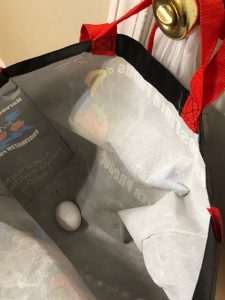 I noticed an odd thing last week.
I noticed an odd thing last week.
Like many, I have been cutting back on trips to the grocery store. Lately, I’ve been going to the store to get groceries every seven to ten days.
Per my list, I picked up lettuce and green beans and zucchini, fresh vegetables that had a good chance of lasting for a while. I picked up a couple cans of white beans and Italian sausage for a crockpot cassoulet recipe (easily parceled out into plastic containers and set into my freezer).
I allowed myself some cookies and ice cream (What’s the use of being stuck inside if you can’t indulge in a guilty pleasure?), and, I picked up a carton of eggs.
Throughout the shopping process, I wore a bandana, that covered my nose and mouth, along with lightweight latex gloves.
Home from shopping, I brought my two tote bags into my kitchen. I employed the precautions for safe grocery handling that has been circulating on the Internet, spraying anything wrapped in plastic with disinfectant and letting other things rest until they were unlikely to carry germs before placing them in the fridge or cabinet.
The egg carton appeared to be the last item in one of my bags. But wait….
As I removed the carton, I spied one loose egg at the bottom of my reusable bag. How did it come out of the formed cardboard carton? How did the egg not break?
While not under a gallon of milk or heavy cans, the eggs were towards the bottom of the bag, keeping company with a head of lettuce, a small bottle of organic dressing, and a plastic container of almonds.
The image made me think about the difference between “fragile” and “vulnerable.” Even though I’ve been limiting how much TV news I consume, I’ve been thinking a lot about this for weeks.
By definition, “fragile” relates to weakness, maybe to poor construction. Something that’s labeled “fragile” is often flimsy or insubstantial, easily broken, damaged, or destroyed.
When I think about an egg, only part of it, the shell, fits this description. The yolk and albumen, the gelatinous white, have their own physical characteristics. When something is fragile, you don’t expect it to survive.
Vulnerability is a whole different matter. Professor and researcher, Brené Brown’s 2010 TED Talk on the subject has drawn over forty-seven million views. A professor and researcher, she has brought a spotlight on the impact things like courage, shame, empathy, and vulnerability have on us as individuals and on our society.
Many are drawn to her insights. Most people want to know how bonds and trusting relationships are created even though we often cite successful relationships as being the result of good chemistry or dumb luck.
Many of us recent shut-ins get regular updates on the casualties of the pandemic. We’ve heard that older people, people that have compromised immune systems, people who have heart disease, or have diabetes, or are obese — these people are more vulnerable to aggressive symptoms of COVID-19.
We also see statistics that show African Americans, often those in poverty, are more vulnerable to the virus’s spread. People who live in more densely populated areas or those who have public-facing jobs, like bus drivers or delivery men or store clerks, are more vulnerable.
We also learn about hundred year-old survivors returning home after hospitalization. Beloved middle-aged fathers who carry more than a few extra pounds and kids with asthma get weaned off of ventilators even though they’re considered among the most vulnerable.
I can’t exactly say why this egg, freed from its carton and loose in bottom of my grocery bag, survived intact, but seeing it taught me a lesson.
Vulnerability alone does not lead to tragedy. It is not a predictor of survival. In fact, vulnerability is a kind of strength.
Vulnerability is about needing something essential that you cannot provide for yourself. When a person needs something that is only available, by grace and compassion, through someone else, that’s actually a good thing.
As long as we can accept that we depend on others for some things and feel confident that we have something of value to offer back, as long as we can celebrate our interdependence, we’re actually strong.
Appreciating the difference between “fragile” and “vulnerable” is no small thing.


Leave a comment